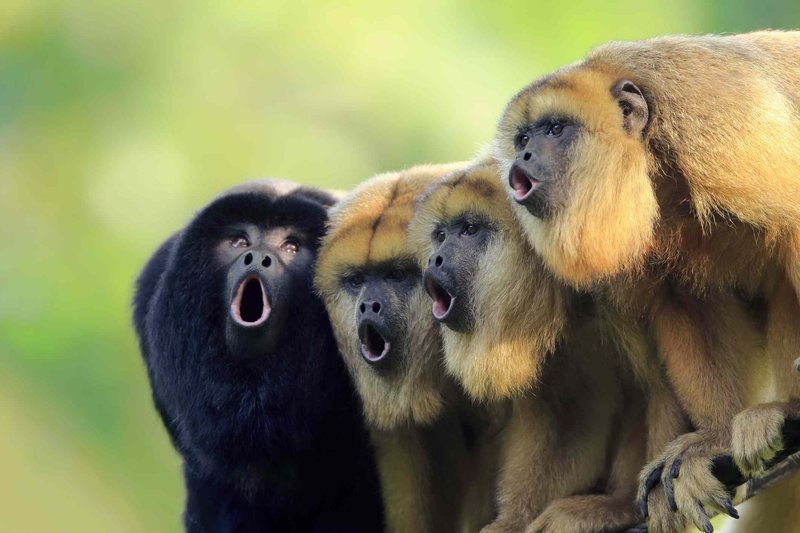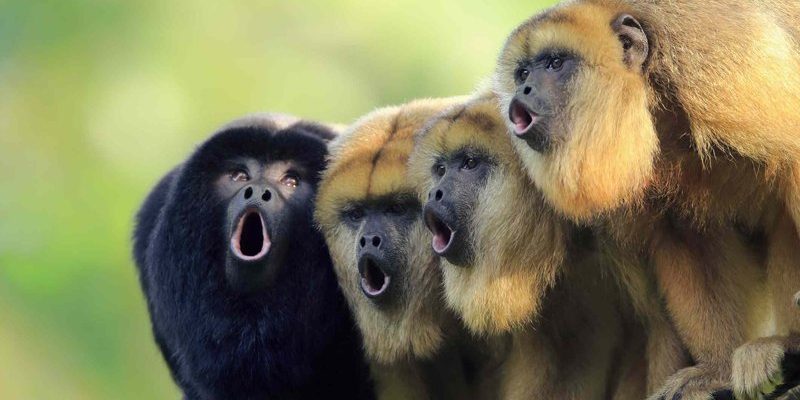
Let’s dive into the world of howler monkeys and separate fact from fiction. Whether you’ve seen them swinging through trees in nature documentaries or heard their howls in the early morning hours, there’s so much to learn. And trust me, understanding these remarkable animals will give you a new appreciation for them.
Myth 1: Howler Monkeys Are Dangerous to Humans
You might have heard stories about howler monkeys attacking people. Honestly, that’s a common misconception. Howler monkeys are not aggressive towards humans unless they feel threatened. They’re actually quite shy and prefer to keep their distance from us.
These monkeys are more interested in feeding on leaves, fruits, and flowers than getting involved in human affairs. If you see one in the wild, it’s best to admire them from afar. They’d rather be left alone, just like most animals. And even if they sound ferocious when they howl, it’s more about communication with their group than a warning to humans.
In essence, the notion that howler monkeys are out to get humans is simply a myth. They’re just trying to live their lives peacefully!
Myth 2: Howler Monkeys Only Live in Rainforests
You might think howler monkeys only hang out in dense rainforests because that’s where we often see them in documentaries. But this isn’t entirely true. While many species of howler monkeys do thrive in tropical rainforests, they can also adapt to different habitats.
In fact, howler monkeys can be found in dry forests, mangrove swamps, and even savannas. This adaptability helps them survive in various environments. For example, the black howler monkey, found in Central America, can often be spotted in semi-deciduous forests, which aren’t rainforests at all.
So, while you might picture these monkeys swinging through lush, green leaves, they’re more versatile than you think. They can be found in a range of ecosystems, showing just how resourceful they can be!
Myth 3: All Howler Monkeys Are the Same
You might be surprised to learn that there are several species of howler monkeys, each with distinct traits and sounds. It’s easy to assume they all look and act the same, but that would be a mistake. There are about seven species of howler monkeys, including the mantled howler, black howler, and yawning howler.
Each species has unique fur colors, sizes, and even vocalizations. For instance, the mantled howler has a striking black coat with golden-yellow fur on its sides, while the colombian howler has a longer tail, which it uses to grasp tree branches as it swings through the canopy.
Moreover, their calls differ. Some howl in a deep, resonating voice, while others have a higher pitch. The diversity among howler monkeys is incredible, and recognizing these differences can enhance your appreciation for these primates.
Myth 4: Howler Monkeys Howl Non-Stop
You’ve probably heard their calls and thought they’re constantly howling, right? That’s another common misunderstanding. While howler monkeys are known for their loud, signature howls, they don’t do it all day long.
Howler monkeys often vocalize early in the morning and late in the afternoon. This timing helps them communicate with other groups and establish territory. Think of their calls as a morning greeting rather than a continuous performance.
In the evenings, they might howl as a way to gather their group before resting for the night. So, while their howls can carry for miles, creating a symphony in the jungle, they actually have a rhythm to it. It’s like songbirds that serenade you at dawn but quiet down later in the day.
Myth 5: Howler Monkeys Are Lazy Animals
Another misconception is that howler monkeys are lazy because they spend a lot of time in trees, lounging around. Sure, they enjoy resting, but they’re anything but lazy! Howler monkeys are quite active and spend a significant portion of their day foraging for food.
Their diet primarily consists of leaves, which requires a lot of energy to digest. This is why you’ll often see them hanging out in trees—leaves are plentiful up there! They also engage in social activities, such as grooming each other and playing. These interactions are essential for maintaining their social structures.
So, the next time you spot a howler monkey lounging on a branch, remember they’re nourishing themselves and engaging in some important monkey business. They may look relaxed, but they’re just smart about how they conserve energy!
Myth 6: Howler Monkeys Are Solitary Creatures
You might think howler monkeys prefer to live alone, but that couldn’t be further from the truth. In fact, howler monkeys are highly social animals. They typically live in troops of around 3 to 15 individuals, usually consisting of a dominant male, several females, and their offspring.
Living in groups offers advantages, like protection from predators and support during foraging. These monkeys rely on their troop members for safety and social interactions. You’ll often find them grooming, vocalizing, or playing together.
This social structure makes them more resilient as a species. Troops work together to care for young and defend their territory from rival groups. So, when you see howler monkeys, you’re witnessing a tight-knit community rather than solitary creatures wandering the jungle.
Myth 7: Howler Monkeys Are Not Endangered
Many people believe howler monkeys are thriving because they’re so prevalent in documentaries. However, the truth is that several howler monkey species are facing threats and are considered vulnerable or endangered. Habitat loss is the biggest concern, primarily due to deforestation and land development.
As forests shrink, these monkeys lose their homes, making it harder for them to find food and reproduce. In addition to habitat loss, hunting and illegal pet trade also pose significant risks to their populations.
Conservation efforts are crucial to help protect howler monkeys and their habitats. Various organizations work to create reserves and educate local communities about the importance of preserving these unique creatures. So, it’s vital to remain informed and support conservation efforts to ensure howler monkeys continue to thrive.
In conclusion, understanding howler monkeys and debunking these myths is essential to appreciating these incredible animals. They’re not just loud primates; they play important roles in their ecosystems and have fascinating social structures. By learning more about them, we can better protect their future and the environments they inhabit. So, the next time you hear a howler monkey in a documentary or a nature show, you’ll know just how special they really are.

